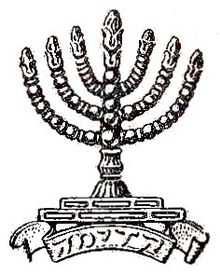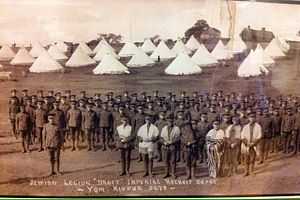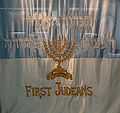Jewish Legion


The Jewish Legion (1917–1921) was the name for five battalions of Jewish volunteers established as the British Army's 38th through 42nd (Service) Battalions of the Royal Fusiliers.
Background


In February 1915, a small committee in Alexandria approved a plan of Zeev Jabotinsky and Joseph Trumpeldor to form a Jewish military unit that would participate in the British effort to liberate Palestine from the Ottoman Empire.[1] The British commander General Maxwell rejected the idea, stating that he doubted that Palestine would be invaded and that foreign nationals were not allowed in the British Army.[1] Maxwell suggested instead that a "mule corps" be formed to serve somewhere else on the Turkish front.[1] Jabotinsky rejected the idea and left for Europe to seek other support for a Jewish unit, but Trumpeldor accepted it and began recruiting volunteers from among the Jews in Egypt who had been deported there by the Ottomans in the previous year.[1] The British Army formed 650 of them into the Zion Mule Corps, of which 562 served in the Gallipoli Campaign.[1]
The British opposed the participation of Jewish volunteers on the Palestinian front and they were put to serve as a detachment for mule transport on another sector of the Ottoman front. Trumpeldor formed the 650-strong Zion Mule Corps, of whom 562 were sent to the Gallipoli front.
Gallipoli Front

On April 25, 1915, together with the first British, Australian, New Zealand and French troops, the Jewish Legion landed on Gallipoli peninsula. Its Commanding Officer was Lieutenant-Colonel John Henry Patterson, DSO, an Irish Protestant, and was met with heavy shelling and machine-gun fire at the shore of Cape Helles. Trumpeldor was Second-in-command; Jabotinsky served as an officer. There, a Distinguished Conduct Medal was awarded to Private M. Groushkowsky, who prevented his mules from stampeding under heavy bombardment and despite being wounded in both arms, delivered the ammunition. Trumpeldor was shot through the shoulder but refused to leave the battlefield. Patterson later wrote: "Many of the Zionists whom I thought somewhat lacking in courage showed themselves fearless to a degree when under heavy fire, while Captain Trumpeldor actually revelled in it, and the hotter it became the more he liked it..."
Official formation

Between the dissolution of the Zion Mule Corps and the formation of the Jewish Legion, Jabotinsky and Trumpeldor and 120 Zion Mule Corps Veterans served together in 16 Platoon of the 20th Battalion, London Regiment.
Finally, in August 1917, the formation of a Jewish regiment was officially announced and it was raised at Fort Edward (Nova Scotia).[2] The unit was designated as the 38th Battalion of the Royal Fusiliers and included British volunteers, as well as members of the former Zion Mule Corps and a large number of Russian Jews. On April 1918, it was joined by the 39th Battalion, made up almost entirely of Jews who were resident in the United States and Canada.
Thousands of Palestinian Jews also applied to join the Legion and in 1918, more than 1,000 were enlisted. Ninety-two Ottoman Jews who had been captured in the fighting earlier were also permitted to enlist. This group was organized as the 40th Battalion. The 41st and 42nd Battalions were depot battalions stationed in Plymouth, England. In his memoirs about the Legion Jabotinsky described the composition of the 5000-member Legion as: "thirty-four per cent from the United States, thirty per cent from Palestine, twenty-eight per cent from England, six per cent from Canada, one per cent Ottoman war prisoners, one per cent from Argentina."
Ultimately, in August 1917, the formation of a Jewish regiment was officially announced. The soldiers of the 38th and 39th Battalions of the Royal Fusiliers, made up almost entirely of Jews from Britain, Russia, United States, Canada, and later the 40th Battalion composed of Jews from the Ottoman provinces of Palestine and other areas, served in the Jordan Valley and fought the Ottomans some twenty miles (32 km) north of Jerusalem.
Action in the Jordan Valley, 1918
In June 1918, the volunteers of the 38th Battalion began engaging the Ottomans some twenty miles north of Jerusalem. In the fighting in the Jordan Valley, more than twenty Legionnaires were killed, wounded, or captured, the rest came down with malaria, and thirty of this group later died. The Legion then came under the command of Major-General Edward Chaytor,[3] who commanded the ANZAC Mounted Division.
Besides various skirmishes, the Legion also participated in the Battle of Megiddo in mid-September, 1918, widely considered to have been one of the final and decisive victories of the Ottoman front.
The Legion's mission was to cross the Jordan River. Jabotinsky led the effort. Later, he was decorated and Chaytor told the Jewish troops: "By forcing the Jordan fords, you helped in no small measure to win the great victory gained at Damascus."
Legacy
| Battalion | Fatalities |
|---|---|
| 38th | 43 |
| 39th | 23 |
| 40th | 12 |
| 42nd | 3 |
| 38th/40th | 9 |
| Transferred from Jewish Legion | 1 |
Almost all the members of the Jewish regiments were discharged immediately after the end of World War I in November 1918. Some of them returned to their respective countries, others settled in Palestine to realize their Zionist aspirations. In late 1919, the Jewish Legion was reduced to one battalion titled First Judeans, and awarded a distinctive cap badge, a menorah with the Hebrew word קדימה Kadima (forward) at the base.
Former members of the Legion took part in the defence of Jewish communities during the Riots in Palestine of 1920, which resulted in the arrest of Jabotinsky. Two former members of the Legion were killed with Trumpeldor at Tel Hai. One former member of the Legion was killed in Tel Aviv-Jaffa during the Jaffa riots of 1921. Some members of the Jewish Legion settled in moshav Avihayil. Another former member died in service in World War II,[5]
Gallery
-

A recruitment poster published in American Jewish magazines. Daughter of Zion (representing the Jewish people): 'Your Old New Land must have you! Join the Jewish regiment.'
-

December 1917. Jewish Legion soldiers at the Western Wall after the British take-over of Jerusalem
-

February 22, 1918 The 38th battalion of the Jewish Legion marches in the streets of London.
-

Col Margolin leading the 39th Battalion of the Jewish Legion through Bet Shemen
-

The Choir of the Jewish Legion
-

The flag of the First Judeans 1919-1921.
-

Lt. Jabotinsky in the uniform of the Royal Fusiliers
-

Private David Ben-Gurion, a volunteer in the Jewish Legion 1918
Members of Jewish Legion
- Gershon Agron, Mayor of Jerusalem.
- Nathan Ausubel, Jewish-American author.
- Yitzhak Ben-Zvi, second Israeli President.
- Yaakov Dori, Haganah leader; first Chief of Staff of the Israel Defense Forces.
- Sir Jacob Epstein, British sculptor.
- Levi Eshkol, third Israeli Prime Minister.
- Louis Fischer, Jewish-American journalist and author.
- Eliyahu Golomb, founding member of the Haganah.
- David Grün, later Ben-Gurion, first Israeli Prime Minister.
- Nachum Gutman, Israeli Painter
- Dov Hoz, Zionist activist, Haganah fighter.
- Bernard Joseph, later Dov Yosef, Governor of Jewish Jerusalem during the 1948 siege; longtime Labor MK.
- Berl Katznelson, Zionist philosopher and activist.
- Reuven Katzenelson-Sgt under Joseph Trumpeldor at Battle of Gallipoli and father of Shmuel Tamir
- Bert "Yank" Levy Internationalist in Spain and Military instructor for the British Home Guard.
- Gideon Mer,[6] physician, veteran of Zion Mule Corps, Jewish Legion and British Army in World War II. Served as medic in Israeli War of Independence; later worked in the Israeli Ministry of Health. {Note: he is the unnamed Officer during World War II in charge of anti-Malaria program mentioned in Martin Sugarman's article on the Zion Mule Corps}.
- John Henry Patterson (author)-Commander of Zion Mule Corps and 38th Battalion Royal Fusiliers {Jewish legion}
- James Armand de Rothschild, D.C.M. Major, 39th Royal Fusiliers Battalion; Captain Royal Canadian Dragoons; a member of the Rothschild family.
- Moshe Smilansky, Pioneer of the First Aliyah, a Zionist leader who advocated peaceful coexistence with the Arabs in Mandatory Palestine, a farmer, and a prolific author.
- Edward Sperling - humorist and later director-general of the Ministry of Trade and Industry under the British Mandate of Palestine
- Edwin Herbert Samuel, 2nd Viscount Samuel; CMG son of Herbert Samuel, 1st Viscount Samuel.
- Eliezer Sukenik, Israeli archaeologist; father of Yigael Yadin
See also
- Jewish Brigade, a similar military formation of volunteer Jews that fought in the Second World War.
- Tilhas Tizig Gesheften, organization which grew out of the Jewish Brigade
References
- ↑ 1.0 1.1 1.2 1.3 1.4 Joseph B. Schechtman (1956). "Rebel and Statesman, The Vladimir Jabotinsky Story, The Early Years. New York: Thomas Yoseloff. pp. 203–207.
- ↑ The Struggle for the Jewish Legion and The Birth of the IDF; By Jerry Klinger
- ↑ Bio of E.W.C. Chaytor (firstworldwar.com)
- ↑ Approximate numbers, according to Commonwealth War Graves Commission
- ↑ S/Sgt Maurice Spero died 27-8-1944
- ↑ "Mer, Professor Gideon". Israel War Veterans League. Archived from the original on 2007-12-25. Retrieved 2008-03-12.
Further reading
- Patterson, John H. With the Judeans in the Palestine campaign. Uckfield : Naval & Military Press, [2004 reprint] ISBN 1-84342-829-6
- Jabotinsky, Vladimir. The story of the Jewish Legion. New York: Bernard Ackerman, 1945. ISBN B0007DE88U
- Freulich, Roman. Soldiers in Judea;: Stories and vignettes of the Jewish Legion. Herzl Press, 1965. ISBN B0007-EN0G-K
- Gilner, Elias. Fighting dreamers; a history of the Jewish Legion in World War One,: With a glimpse at other Jewish fighting groups of the period. 1968. ASIN B0006BT7KM
- Gilner, Elias. War and Hope. A History of the Jewish Legion. New York; Herzl Press: 1969. ISBN B0006C2O2E
- Kraines, Oscar. The soldiers of Zion: The Jewish Legion, 1915-1921. 1985. ASIN B0006YWX5U
- Lammfromm, Arnon, Izhak Ben-Zvi and the Commmoration of Joseph Binyamini: A Failed Attempt to Create a Site of National Heritage", Archion, 17, Winter 2013, pp.48-55, 68 (Hebrew and English abstract)
- Marrion, R.J. "The Jewish Legion," 39th (service) battalion, Royal Fusiliers (City of London Regiment), 1918-1919. 1987. ASIN B000719GOS
- Watts, Martin. The Jewish Legion and the First World War. 2004. ISBN 1-4039-3921-7
- "When the spirit of Judah Maccabee hovered over Whitechapel Road — The march of the 38th Royal Fusiliers" by Martin Sugarman, Western Front Association Journal, Jan 2010. Also google on virtual Jewish Library using title
External links
- The Zion Muleteers of Gallipoli (March 1915 - May 1916) by Martin Sugarman (JVL). Accessed June 21, 2006.
- Jewish legion and Jewish East end of London Link